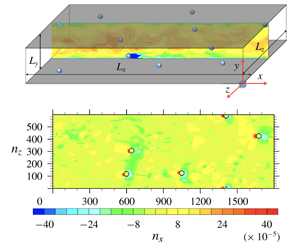Crossref Citations
This article has been cited by the following publications. This list is generated based on data provided by
Crossref.
Hu, Liangquan
Dong, Zhiqiang
Peng, Cheng
and
Wang, Lian-Ping
2021.
Direct Numerical Simulation of Sediment Transport in Turbulent Open Channel Flow Using the Lattice Boltzmann Method.
Fluids,
Vol. 6,
Issue. 6,
p.
217.
Yang, Bo
Peng, Cheng
Wang, Guichao
and
Wang, Lian-Ping
2021.
A direct numerical simulation study of flow modulation and turbulent sedimentation in particle-laden downward channel flows.
Physics of Fluids,
Vol. 33,
Issue. 9,
Wu, Zhi-feng
Wu, Jian-zhao
Wang, Bo-fu
and
Lu, Zhi-ming
2022.
Effect of Stokes number on energy modulation of the fluid in turbulent particle-laden channel flows.
Journal of Hydrodynamics,
Vol. 34,
Issue. 3,
p.
510.
Varaksin, Aleksey Yu.
and
Ryzhkov, Sergei V.
2022.
Turbulence in Two-Phase Flows with Macro-, Micro- and Nanoparticles: A Review.
Symmetry,
Vol. 14,
Issue. 11,
p.
2433.
Verwey, C.
and
Birouk, M.
2023.
Modulation of forced isotropic turbulence by an anchored droplet with near-Kolmogorov diameter and varying volatility.
Journal of Fluid Mechanics,
Vol. 966,
Issue. ,
2023.
Effects of the hidden errors in the bounce back scheme on the lattice Boltzmann simulation of the turbulent channel flow using the multiple-relaxation-time collision model.
Physics of Fluids,
Vol. 35,
Issue. 5,
Wang, Cheng
Jiang, Linfeng
and
Sun, Chao
2023.
Numerical study on turbulence modulation of finite-size particles in plane-Couette flow.
Journal of Fluid Mechanics,
Vol. 970,
Issue. ,
Zhu, Zhengping
Hu, Ruifeng
and
Zheng, Xiaojing
2023.
A multiple-time-step integration algorithm for particle-resolved simulation with physical collision time.
International Journal of Multiphase Flow,
Vol. 163,
Issue. ,
p.
104411.
Fei, Linlin
Qin, Feifei
Wang, Geng
Huang, Jingwei
Wen, Binghai
Zhao, Jianlin
Luo, Kai H.
Derome, Dominique
and
Carmeliet, Jan
2023.
Coupled lattice Boltzmann method–discrete element method model for gas–liquid–solid interaction problems.
Journal of Fluid Mechanics,
Vol. 975,
Issue. ,
Fei, Linlin
Qin, Feifei
Zhao, Jianlin
Derome, Dominique
and
Carmeliet, Jan
2023.
Lattice Boltzmann modelling of isothermal two-component evaporation in porous media.
Journal of Fluid Mechanics,
Vol. 955,
Issue. ,
Shen, Jie
Peng, Cheng
Lu, Zhiming
and
Wang, Lian-Ping
2024.
The influence of particle density and diameter on the interactions between the finite-size particles and the turbulent channel flow.
International Journal of Multiphase Flow,
Vol. 170,
Issue. ,
p.
104659.
Motoori, Yutaro
and
Goto, Susumu
2025.
Attenuation mechanism of wall-bounded turbulence by heavy finite-size particles.
Journal of Fluid Mechanics,
Vol. 1014,
Issue. ,
Ma, Yupeng
Qiu, Xiang
Xia, Yuxian
Zhang, Shuang
Shen, Jie
and
Liu, Yulu
2025.
The modulation of the turbulent structures in channel flow with porous and rough wall.
Physics of Fluids,
Vol. 37,
Issue. 2,
Wang, Yuqi
and
Hu, Ruifeng
2025.
A stochastic force model for a finite-size spherical particle in turbulence.
International Journal of Multiphase Flow,
Vol. 191,
Issue. ,
p.
105300.
Li, Jia-Qing
Wang, Ya-ping
Wang, Zhi-Hui
He, Tian-Pei
Niu, Xiao-Dong
Khan, Adnan
and
Yamaguchi, Hiroshi
2025.
A lattice Boltzmann-based diffuse interface immersed-boundary scheme for gas-liquid-solid multiphase flow.
Computers & Mathematics with Applications,
Vol. 199,
Issue. ,
p.
325.
Marchioli, Cristian
Bourgoin, Mickael
Coletti, Filippo
Fox, Rodney
Magnaudet, Jacques
Reeks, Michael
Simonin, Olivier
Sommerfeld, Martin
Toschi, Federico
Wang, Lian-Ping
and
Balachandar, S.
2025.
Particle-laden flows.
International Journal of Multiphase Flow,
Vol. 191,
Issue. ,
p.
105291.


